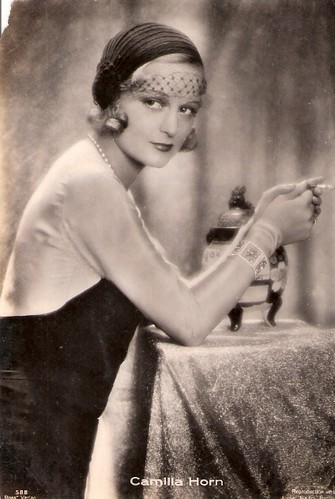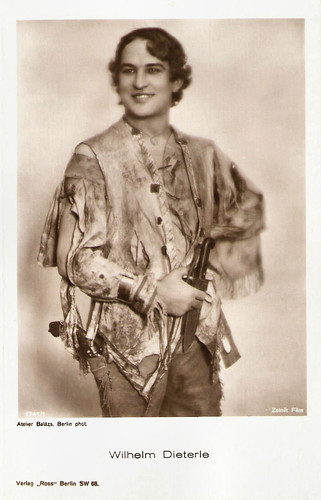Today, the subject of our series on film star photographers is Atelier Balázs. This little known Berlin studio was active during the Weimar period. The photographs of Atelier Balázs were often used for the sepia postcards of Ross Verlag.
![Lya Mara]()
Lya Mara. German postcard by Ross Verlag, no. 3599/2, 1928-1929. Photo: Atelier Balázs, Berlin.
![Lilian Weiss]()
Lilian Weiss. German postcard by Ross Verlag, Berlin. Photo: Atelier Balázs, Berlin.
![Erna Morena]()
Erna Morena. German postcard by Ross Verlag, no. 3423/1, 1928-1929. Photo: Atelier Balázs, Berlin.
![Evi Eva]()
Evi Eva. German postcard by Ross Verlag, no. 3518/2, 1928-1929. Photo: Atelier Balázs, Berlin.
![Aud Egede Nissen]()
Aud Egede Nissen. German postcard. by Ross Verlag, Berlin, no. 3534/1, 1928-1929. Photo: Atelier Balázs, Berlin.
![Camilla Horn]()
Camilla Horn. German postcard by Ross Verlag, no. 588. Photo: Atelier Balázs, Berlin.
Although Atelier Balázs contributed several portraits to the postcards of Ross Verlag, there is nothing known about the studio, The WikiProjekt Stummfilm/Stummfilmfotografen has not identified yet who Balázs was, when he or she was born and where.
Most of the photos are made in the second part of the 1920s. The studio was active in the German capital at the same time as film critic, screen writer and director Béla Balázs. Were they connected?
Béla Balázs (1884-1949) was born as Herbert Bauer in Szeged in Austria-Hungary (now Hungary). He was the son of Jewish German-born parents, adopting his nom de plume in newspaper articles written before his 1902 move to Budapest, where he studied Hungarian and German at the Eötvös Collegium.
The collapse of the short-lived Hungarian Soviet Republic under Béla Kun in 1919 began a long period of exile in Vienna and Germany and, from 1933 until 1945, the Soviet Union.
In Vienna he became a prolific writer of film reviews. His first book on film, Der Sichtbare Mensch (The Visible Man) (1924), helped found the German 'film as a language' theory, which influenced directors Sergei Eisenstein and Vsevolod Pudovkin.
A popular consultant, he wrote the screenplay for G. W. Pabst's film of Die Dreigroschenoper/The Three Penny Opera (1931), which became the object of a scandal and lawsuit by Brecht (who admitted to not reading the script) during production.
Later, he and Carl Mayerco-wrote Leni Riefenstahl's Das Blaue Licht/The blue light (1932). He also helped Riefenstahl to direct the film, but she later removed his and Mayer's name from the credits because they were Jewish.
After the war, he returned to Hungary to help rebuild the film industry there. One of his best known films is Valahol Európában/Somewhere in Europe (Géza von Radványi, 1947).
Was Atelier Balázs a side job for Béla Balázs? Probably not, while he moved to Berlin in 1926, and some of the portraits, like the one for Karl Beckersachs were already made in the years before. But who was the photographer behind Atelier Balázs then?
![Karl Beckersachs]()
Karl Beckersachs. German postcard by Ross Verlag, Berlin, no. 348/3, 1919-1924. Photo: Atelier Balász.
![Mia Pankau]()
Mia Pankau. German postcard by Ross Verlag, nr. 1031/1, 1927-1928. Photo: Atelier Balázs, Berlin.
![Mia Pankau]()
Mia Pankau. German postcard by Ross Verlag, no. 1031/2, 1927-1928. Photo: Atelier Balázs, Berlin.
![Luciano Albertini]()
Luciano Albertini. German postcard by Ross Verlag, no. 1287/1, 1927-1928. Photo: Atelier Balázs, Berlin / Albertini-Produktion GmbH.
![Luciano Albertini]()
Luciano Albertini. German postcard by Ross Verlag, no. 3032/1, 1928-1929. Photo: Atelier Balázs, Berlin. This picture was also used for the cover of the magazine Film-Woche, no. 17, 1929, to announce Albertini's film Tempo! Tempo! (Max Obal, 1929).
![Arne Molander]()
Arne Molander. German Postcard by Ross Verlag, Berlin, no. 1131/2, 1927-1928. Photo: Atelier Balázs, Berlin.
![Lya Mara]()
Lya Mara. German postcard by Ross Verlag, no. 1368/2, 1927-1928. Photo: Atelier Balázs, Berlin.
![Lilian Hall-Davis]()
Lilian Hall-Davis. German postcard by Ross Verlag, Berlin, no. 1370/1, 1927-1928. Photo: Atelier Balázs, Berlin.
![Wilhelm Dieterle]()
Wilhelm Dieterle. German postcard by Ross Verlag, no. 1741/1, 1927-1928. Photo: Atelier Balázs, Berlin / Zelnik Film.
![Lucy Doraine]()
Lucy Doraine. German postcard by Ross Verlag, no. 3054/2, 1928-1929. Photo: Atelier Balázs, Berlin.
Check out our other posts on film star photographers. See the links at right under the caption 'The Photographers'.
Sources: Wikipedia.

Lya Mara. German postcard by Ross Verlag, no. 3599/2, 1928-1929. Photo: Atelier Balázs, Berlin.

Lilian Weiss. German postcard by Ross Verlag, Berlin. Photo: Atelier Balázs, Berlin.

Erna Morena. German postcard by Ross Verlag, no. 3423/1, 1928-1929. Photo: Atelier Balázs, Berlin.

Evi Eva. German postcard by Ross Verlag, no. 3518/2, 1928-1929. Photo: Atelier Balázs, Berlin.

Aud Egede Nissen. German postcard. by Ross Verlag, Berlin, no. 3534/1, 1928-1929. Photo: Atelier Balázs, Berlin.

Camilla Horn. German postcard by Ross Verlag, no. 588. Photo: Atelier Balázs, Berlin.
The visible man
Although Atelier Balázs contributed several portraits to the postcards of Ross Verlag, there is nothing known about the studio, The WikiProjekt Stummfilm/Stummfilmfotografen has not identified yet who Balázs was, when he or she was born and where.
Most of the photos are made in the second part of the 1920s. The studio was active in the German capital at the same time as film critic, screen writer and director Béla Balázs. Were they connected?
Béla Balázs (1884-1949) was born as Herbert Bauer in Szeged in Austria-Hungary (now Hungary). He was the son of Jewish German-born parents, adopting his nom de plume in newspaper articles written before his 1902 move to Budapest, where he studied Hungarian and German at the Eötvös Collegium.
The collapse of the short-lived Hungarian Soviet Republic under Béla Kun in 1919 began a long period of exile in Vienna and Germany and, from 1933 until 1945, the Soviet Union.
In Vienna he became a prolific writer of film reviews. His first book on film, Der Sichtbare Mensch (The Visible Man) (1924), helped found the German 'film as a language' theory, which influenced directors Sergei Eisenstein and Vsevolod Pudovkin.
A popular consultant, he wrote the screenplay for G. W. Pabst's film of Die Dreigroschenoper/The Three Penny Opera (1931), which became the object of a scandal and lawsuit by Brecht (who admitted to not reading the script) during production.
Later, he and Carl Mayerco-wrote Leni Riefenstahl's Das Blaue Licht/The blue light (1932). He also helped Riefenstahl to direct the film, but she later removed his and Mayer's name from the credits because they were Jewish.
After the war, he returned to Hungary to help rebuild the film industry there. One of his best known films is Valahol Európában/Somewhere in Europe (Géza von Radványi, 1947).
Was Atelier Balázs a side job for Béla Balázs? Probably not, while he moved to Berlin in 1926, and some of the portraits, like the one for Karl Beckersachs were already made in the years before. But who was the photographer behind Atelier Balázs then?

Karl Beckersachs. German postcard by Ross Verlag, Berlin, no. 348/3, 1919-1924. Photo: Atelier Balász.

Mia Pankau. German postcard by Ross Verlag, nr. 1031/1, 1927-1928. Photo: Atelier Balázs, Berlin.

Mia Pankau. German postcard by Ross Verlag, no. 1031/2, 1927-1928. Photo: Atelier Balázs, Berlin.

Luciano Albertini. German postcard by Ross Verlag, no. 1287/1, 1927-1928. Photo: Atelier Balázs, Berlin / Albertini-Produktion GmbH.

Luciano Albertini. German postcard by Ross Verlag, no. 3032/1, 1928-1929. Photo: Atelier Balázs, Berlin. This picture was also used for the cover of the magazine Film-Woche, no. 17, 1929, to announce Albertini's film Tempo! Tempo! (Max Obal, 1929).

Arne Molander. German Postcard by Ross Verlag, Berlin, no. 1131/2, 1927-1928. Photo: Atelier Balázs, Berlin.

Lya Mara. German postcard by Ross Verlag, no. 1368/2, 1927-1928. Photo: Atelier Balázs, Berlin.

Lilian Hall-Davis. German postcard by Ross Verlag, Berlin, no. 1370/1, 1927-1928. Photo: Atelier Balázs, Berlin.

Wilhelm Dieterle. German postcard by Ross Verlag, no. 1741/1, 1927-1928. Photo: Atelier Balázs, Berlin / Zelnik Film.

Lucy Doraine. German postcard by Ross Verlag, no. 3054/2, 1928-1929. Photo: Atelier Balázs, Berlin.
Check out our other posts on film star photographers. See the links at right under the caption 'The Photographers'.
Sources: Wikipedia.